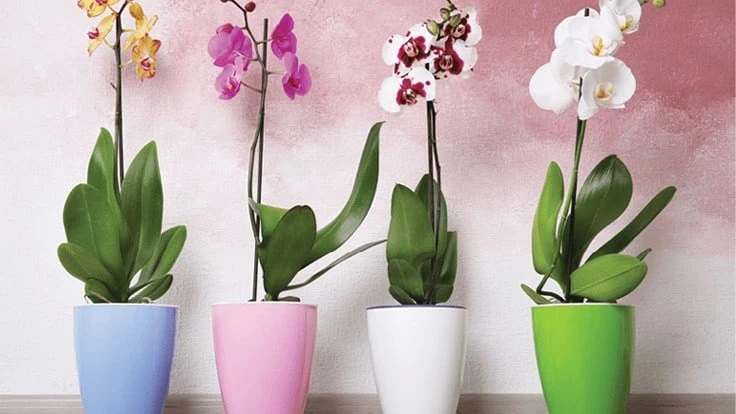

Color me happy
Pure white moth orchids are lovely, albeit a bit somber for the times. An infusion of cheerful color is in order, and I am seeing that reflected on popular plant sites in terms of their orchid offerings. Beyond white Phalaenopsis, pops of orange, yellow and pink are becoming more common. Tropical colors that evoke “vacation” are emerging as décor trends right and orchids certainly stimulate a sense of island escape. Vacations — you remember, those things we used to be able to take from time to time to some place warm, tropical and cheery?
Let’s rebloom!
While Phalaenopsis spp. may already seem ubiquitous to those of us in the industry, most new houseplant parents have yet to even dip their toes into the world of orchids. Most do not yet understand the basic care for even the easiest of orchids, how relatively easy it is to care for and even rebloom moth orchids. The narrative that orchids are hard to care for and too challenging for beginner plant parents keeps many consumers from spending their hard-earned money on them. So, from a marketing perspective, let’s try and reach a bit further to ease their concerns — at least when it comes to moth orchids.
In fact, I think we’re missing out on a big marketing opportunity by not better promoting the how-to guides of reblooming moth orchids. I know that most growers just want customers to pitch their old plant when it is finished blooming and buy a new one. I do not think there will ever be any shortage of the “décor-only” customers who treat moth orchids as disposable; you need not fear those that want to keep and rebloom their plants. Cater to them all. After all, that success in reblooming their moth orchid will most likely prompt them to buy more. It’s like plant propagation: just because plant keepers figure out how to root cuttings, does not mean they stop buying new plants. Often, the opposite is true. It certainly is for me! The more success customers have with easy orchids, the more they are likely to buy.
Perfectly petite
Petite and miniature orchids are trending, and the miniature phalaenopsis are perfect desk companions, not to mention perfect for tucking into already crowded windowsills. Beyond moth orchids, many new plant collectors are also diving into more unusual orchid species and growing on the small side (yes, I will keep pounding my tiny plant drum). If you haven’t noticed, indoor gardeners are converting Ikea glass cabinets — as well as all sorts of other storage units — into DIY Wardian cases for their smaller plants in droves. It is a THING. Now that they have figured out higher humidity is required for many of their pricier plants, they are going the extra mile to customize their growing environments. Micro and miniature orchids are the perfect specimens for these dedicated indoor gardeners.
“When it comes to orchid trends for 2021 and into 2022, I don’t think we need to do any reinventing of the wheel.”
Oldies but goodies
In terms of other genera that could I think could see a rebound or increase in popularity, Oncidium -— with their dramatic abundance of blooms — make an intensely cheerful impression. I think Zygopetalum are particularly seductive, with their striking purple and green flower colors and intense fragrances. Miltoniopsis cultivars rival Phalaenopsis in their flower display and offer up a lovely fragrance. I also consider Paphiopedilum to be some of the easiest orchids to grow as indoor houseplants and do not really get the houseplant marketing they deserve.
Go Goth
On the flipside of the cheery tropical color trend, plant parents are also going Goth with their flower and foliage choices. “Black” foliage and black flowers — the stranger the better — are also in. A strange plant enthusiast myself, flowers and foliage that approach black in their color have always fascinated me, and I frankly find them just as cheery as brightly colored plants. I suspect many new plant enthusiasts feel the same. Luckily, there are some lovely Paphiopedilum, Oncidium, Cymbidium, Vanda and Phalaenopsis hybrids that sport dark or almost black blooms or flower markings. If you have such offerings, I would suggest you get them Instagram ready ASAP.
When it comes to orchid trends for 2021 and into 2022, I do not think we need to do any reinventing of the wheel. We already have what indoor plant collectors want and the market is prime for a big orchid boost. We just need to make a stronger effort to reach out to the new influx of houseplant enthusiasts that have flooded our market over the last year and provide better education. Put your top five easy-to-grow orchids front and center, shake up your color mix, and find your visual voice on social media.

Explore the June 2021 Issue
Check out more from this issue and find your next story to read.
Latest from Greenhouse Management
- Anthura acquires Bromelia assets from Corn. Bak in Netherlands
- Top 10 stories for National Poinsettia Day
- Langendoen Mechanical hosts open house to showcase new greenhouse build
- Conor Foy joins EHR's national sales team
- Pantone announces its 2026 Color of the Year
- Syngenta granted federal registration for Trefinti nematicide/fungicide in ornamental market
- A legacy of influence
- HILA 2025 video highlights: John Gaydos of Proven Winners





